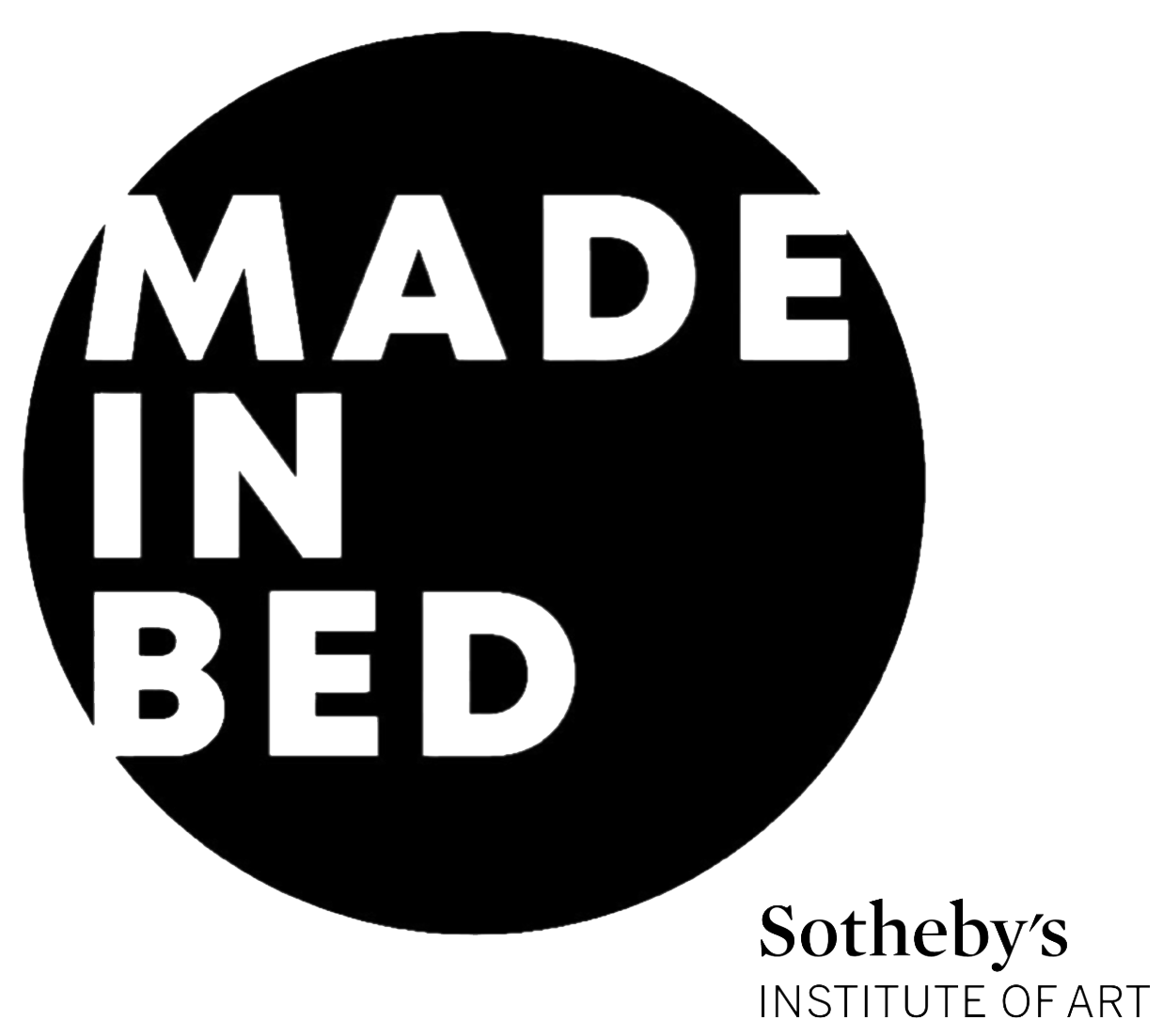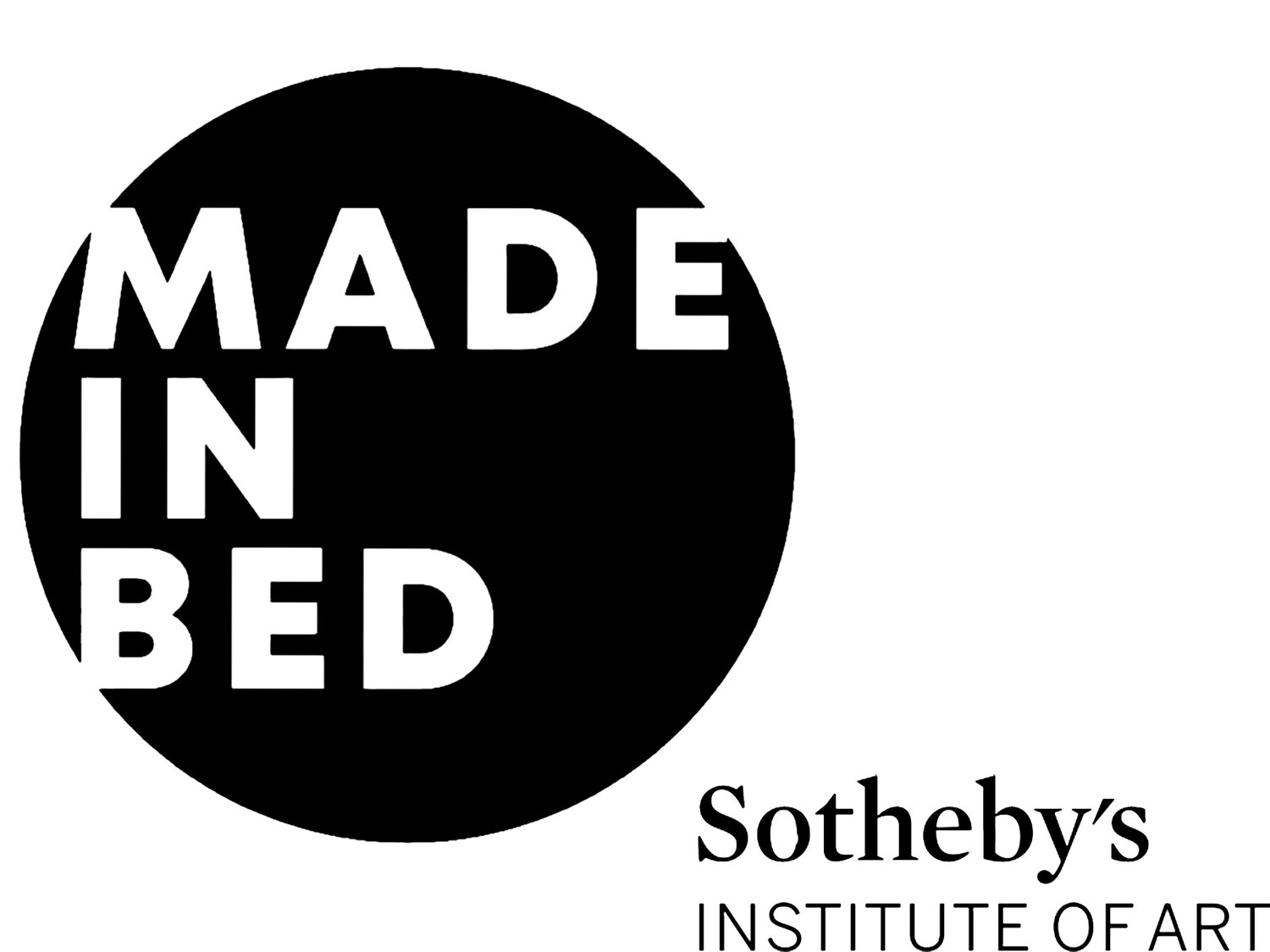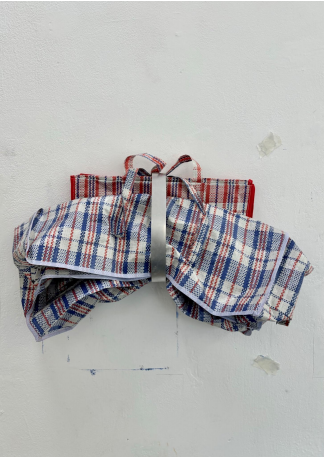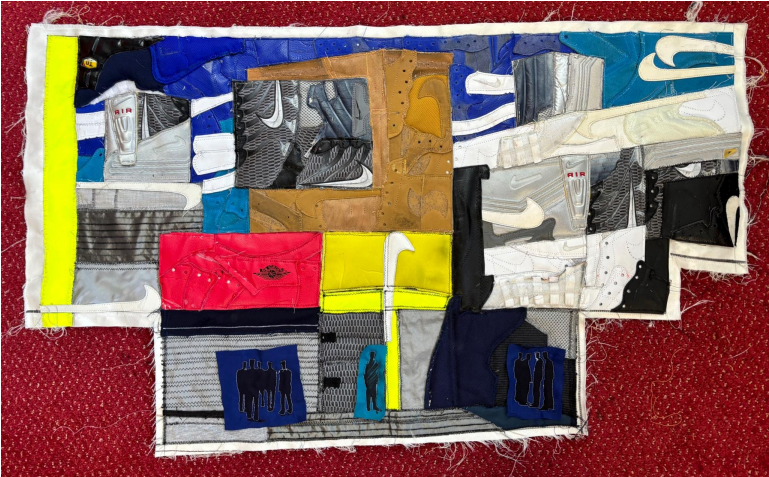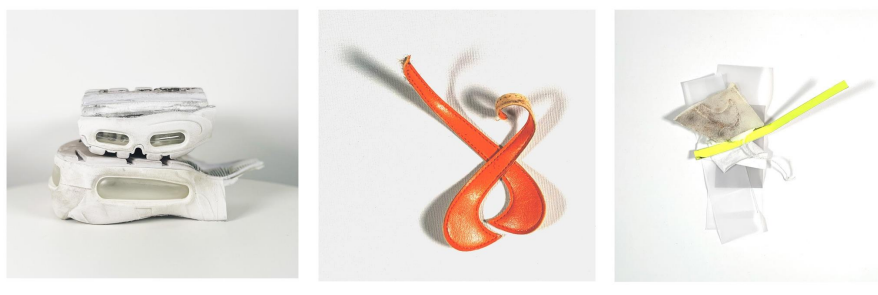George Moore
George Moore, an 18-year-old artist from Kent, is already building an impressive career with his multidisciplinary practice spanning painting, sculpture, patterns, and textiles. Currently studying Fine Art at Chelsea College of Art, Moore’s artistic journey took a pivotal turn at the age of 16 when he was awarded the prestigious, fully funded Ralph Steadman Fine Art Scholarship to study at Rochester Independent College (RIC).
George Moore. Photo Courtesy: the artist.
Moore fondly recalls his time at RIC, particularly under the guidance of his teacher Robin, whom he describes as “truly brilliant.” Reflecting on this transformative period, he says, “He just let me sit, think, draw, and work.” It was in this environment that Moore began to develop his unique artistic identity, taking advantage of the freedom to explore and innovate.
George Moore, Distractions, 2023. Oil pastel on cardboard and airbrush on cardboard, 190 x 290 mm each. Photo Courtesy: the artist.
During his time at RIC, Moore found it challenging to draw inspiration from Kent, prompting him to visit galleries and seek inspiration in the city. Distractions began as a simple sketch he drew while sitting on a park bench in London, capturing street scenes through quick, minimalist lines. He later abstracted and manipulated these initial drawings, transforming them into a more complex work. This process of distilling the “essence” of a scene, rather than directly replicating it, reflects the influence of Cubism on his art. For Moore, the joy lies not just in the final product but in the creative process itself.
Color is central to Moore’s practice, particularly his use of blue. For him, blue represents the essence of the city. By working in blue and white, he achieves the simplicity of black-and-white compositions while adding vibrancy.
“ To me, the city is blue. It’s not about mood or emotion—it’s the city itself.”
George Moore, Untitled, 2023. Oil pastel on cardboard. 190 x 290 mm each. Photo Courtesy: the artist.
In this piece, George Moore explores the interplay of blue and pink. “I really love blue, but I find it fascinating to see how pink works with it to create this delicate balance,” he shares. While blue reflects urban spaces and identities, the recurring use of pink on his figures’ faces demonstrates his focus on color coordination and contrast, prioritizing visual harmony over symbolism.
Reflecting on his earlier work, Moore explains, “During my time at RIC, my paintings often depicted lone male characters in a symbiotic relationship with their urban environment.” Rendered in abstract forms yet clearly recognizable, these figures align with the Cubist philosophy of conveying essence without literal representation.
Moore also takes inspiration from Bauhaus principles, which emphasize simplicity and functionality over decoration. He incorporates geometric shapes and clean lines into his work, reflecting the urban spaces around him. Having grown up in Kent, where tall buildings were rare, London’s skyscrapers felt new and exciting, offering a fresh perspective that greatly influenced his art.
Figures standing in doorways or on staircases symbolize his own moments of transition.
“ I often find that through my work, I uncover stories I wasn’t even aware of at the time. When I look back, I’ll realize, ‘Oh, that’s why this was expressed in this way.”
This unconscious storytelling through his creative process adds a rich, introspective dimension to his artistic narrative.
“These pieces, I think, reflect a period of change before I moved to London. But now that I’m here, my focus has shifted—it’s less about that transition and more about where I am now and my current identity”
Five months ago, George Moore moved to London, opening new doors of opportunity at Chelsea College of Arts. Since relocating, a significant shift has taken place in his artistic practice. Living away from home has led Moore to deeply reflect on his past, present, and future direction. This change in environment has profoundly influenced his artistic thought process and the themes he explores in his work.
Moore now resides in Peckham, a neighborhood known for its multicultural vibrancy, where Nigerian, Taiwanese, and Thai influences coexist alongside a deep-rooted British identity. This unique environment starkly contrasts with his upbringing in Kent, a culturally homogeneous region. This sharp cultural contrast has given Moore a fresh perspective, providing a wealth of inspiration for his art.
George Moore, Untitled, 2024 Found and repurposed steel band and repurposed plastic woven bags. 600 x 260 mm. Photo Courtesy: the artist.
His first university project began as an exploration of his new life and surroundings in London. This led to a closer observation of everyday objects, particularly the ubiquitous bags often seen in Peckham. Moore, who has a keen interest in textiles and patterns, was captivated by the intricate designs on market bags. Among them, he even discovered a Burberry-patterned version, which was distinctly British. However, he decided not to use it, as he wanted to make something that could resonate with a wider audience, not exclusively British people.
Moore transformed their utilitarian function, mounting them on a wall in a way that removed their original purpose, giving them a sculptural quality instead. Adding another layer of intrigue to the work, Moore discovered that these bags originally came from Hong Kong. The multicultural elements commonly seen in London and Peckham are intertwined with the migration journey of these bags, evoking a sense of “settlement” in a new place. This connection is particularly compelling, as it ties into George’s own experience of moving to London and marks his first project after relocating.
In his new environment, George Moore finds fresh perspectives, but some memories linger more vividly. Comparing his childhood in Kent with his current life in London, he reflects on what he has lost and gained. For Moore, this process feels like carrying a piece of home into a new space, allowing him to weave a unique narrative that bridges past and present.
“Even a brief visit home sparks countless ideas, which I bring back to London and incorporate into my work”
George Moore, Untitled. 2024. Deconstructed trainer parts. 940 x 560mm. Photo Courtesy: the artist.
One place that evokes his personal history is the quintessential boot fair experience. From a young age, Moore accompanied his parents, avid collectors, to these fairs almost every weekend. Today, many of the materials he uses in his art—canvases, papers, and other objects—are secondhand finds. Among these, one of his standout creations is a collage, made using 30 pairs of shoes.
Moore’s interest in sustainability within the fashion industry naturally extended to footwear, a category he views as disposable yet underutilized for recycling. “Shoes are often thrown away rather than repurposed,” he explains. Taking advantage of the affordability of boot fairs, he purchased the shoes at a fraction of their cost. Transforming these discarded items into art was no small feat; dismantling a single shoe took over an hour. Over several weeks, he meticulously deconstructed and repurposed the materials into sculptural works, exploring themes of sustainability and the transformation of the mundane into something meaningful.
George Moore, Untitled, 2024. Deconstructed trainer parts. 120 mm each. Photo Courtesy: the artist.
“Air Max is more than a fashion statement where I’m from—it’s part of the local identity”
A recurring motif in these pieces is his choice of Nike Air Max, a brand deeply intertwined with the culture of his hometown. By incorporating these shoes into his work, Moore not only highlights themes of regional culture but also reflects on how everyday objects carry layered meanings.
As integral to his childhood as boot fairs, was his early exposure to cinema. Influenced by his mother, a former film studies teacher, Moore frequently visited the cinema from a young age and developed a taste for so-called “niche films.” Given the significant role cinema plays in his life, it’s no surprise that Moore is now experimenting with filmmaking and documentary projects as a way of stepping out of his comfort zone.
Among his favorite films is La Haine, a French black-and-white drama exploring gang conflict. Its unique narrative and gritty realism have deeply inspired him, and one can only anticipate how these cinematic influences will shape his future works. Whether through sculptural assemblages or his first foray into filmmaking, Moore’s creative journey promises to be as dynamic and multifaceted as the mediums he engages with.
He is now exploring video as a new medium through his school program, pushing the boundaries of his artistic practice. This new direction opens up exciting possibilities, and it will be fascinating to see how his artistic vision unfolds in this dynamic medium.
To find out more about George Moore, connect via Instagram.
Jiwon Ko
Emerging Artist Co-Editor, MADE IN BED
